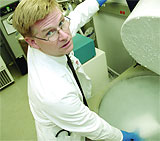 |
 |
|||||
 |
 |
 |
 |
 |
|||
 Dr. Patrick Stiff works with umbilical cord cells. Catholic New World/ David V. Kamba |
Good and bad
Stem-cell project aids Loyola research By Michelle Martin Staff writer In the next two years, Dr. Patrick Stiff hopes to grow umbilical cord stem cells in his laboratory. He hopes to use them to develop new immune cells, and implant those immune cells first in mice and then, if all goes well, in humans. He will do the projects in his capacity as a cancer researcher at Loyola University Medical Center in Maywood, with $1.4 million in funding from the Illinois Regenerative Medicine Institute. The Catholic Conference of Illinois, the public policy arm of the church in our state, opposes the institute, which was created by Gov. Rod Blagojevich last year with a $10 million line item in the budget—a move Blagojevich made after failing to win legislative approval. The Catholic Conference opposes both the purpose of the institute, which awards grants for projects dealing with embryonic as well as non-embryonic stem cells, and the back-door process the governor used to create it, said Zach Wichmann, the assistant director of the conference. The church’s opposition to embryonic stem cell research is because the only way to procure the stem cells is to kill embryos. That’s not the case with the stem cells in umbilical cord blood, said Stiff. Umbilical cord stem cells are routinely discarded after babies are born, although more parents are choosing to either bank umbilical cord blood because their own children might need it in the future or donate it for research. Umbilical cord blood stem cells also have the advantage of being far less likely to be rejected by a recipient’s body, Stiff said, so doctors do not need to find a perfect match, as they do for a bone marrow transplant. Already, Loyola and other hospitals use cord blood—whose cells are similar to very primitive bone marrow cells—for bone marrow transplants, a common treatment for cancers of the blood and bone marrow. The problem is, he said, that there simply aren’t enough cells in each umbilical cord. “If we want to transplant a 20-pound kid, it’s no problem,” he said. “But of we want to transplant a stocky Midwesterner who weighs 250 pounds, there’s not enough cells.” But if Stiff and his team of researchers could take the cells from an umbilical cord and make them reproduce themselves outside the body, they could make enough to treat adults, he said. Loyola has performed more than 40 adult umbilical cord blood transplants already and was the first to report the successful use of cells grown outside of the body for transplantation purposes. Loyola has the largest bone marrow transplantation program in Illinois, performing 160 transplants each year. It is a participating center in the National Marrow Donor Program network “The goal of the umbilical cord blood stem cell transplant is to replace diseased or nonfunctional stem cells with healthy stem cells,” said Stiff, professor of medicine and pathology at the Loyola University Chicago Stritch School of Medicine. “The transplant can also be used to replace cancer patient’s bone marrow cells that are damaged from high-dose chemotherapy or radiation therapy. These new cells may cause the bone marrow to again function normally.” The other project the grant will fund is an effort to get umbilical cord stem cells to develop as immune cells. If that works, the immune cells could be used in clinical trials by the end of the two-year grant period, Stiff said. Eventually, Stiff hopes to see umbilical cord stem cells used to grow all kinds of tissue, which could then be transplanted into patients—everything from heart muscle to liver tissue. Such tissues then could be grafted onto damaged organs, much the way skin grafts are now used to treat severe burns, he said. The beauty of umbilical cord stem cells is that they have no immunity of their own, and so far have not triggered the kind of rejection that transplants of adult tissues. Embryonic stem cells pose the same rejection problems. Stiff said, because they have their own genetic composition. The only way around that would seem to be to clone the recipient, which poses even more ethical problems, Stiff said. Even without church teaching forbidding the destruction of embryos, Stiff said there are all kinds of problems posed by procuring enough embryos to pursue embryonic stem cell research. Most proponents talk about using the thousands of “spare” embryos frozen and stored in fertility clinics, he said. But so far, the number of embryos whose parents have released them for research would lead to only a few dozen embryonic stem cell lines—not enough for meaningful work. “To expect that parents will suddenly start giving their embryos to research would be folly,” he said. |
||
|
|
|||